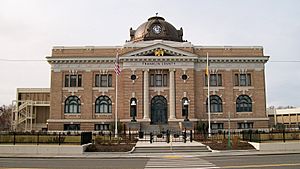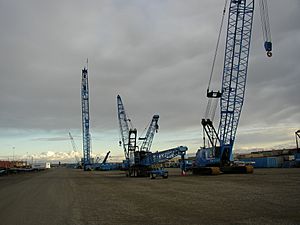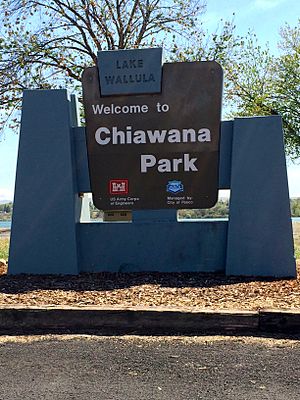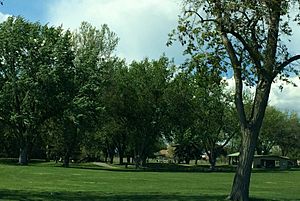Pasco, Washington facts for kids
Quick facts for kids
Pasco
|
|
|---|---|

Pasco City Hall
|
|
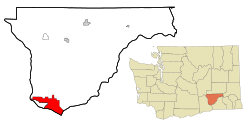
Location of Pasco, Washington
|
|
| Country | United States |
| State | Washington |
| County | Franklin |
| Founded | 1891 |
| Incorporated | September 3, 1891 |
| Government | |
| • Type | Council–manager |
| Area | |
| • City | 37.50 sq mi (97.13 km2) |
| • Land | 33.96 sq mi (87.95 km2) |
| • Water | 3.54 sq mi (9.18 km2) |
| Elevation | 387 ft (118 m) |
| Population
(2020)
|
|
| • City | 77,108 |
| • Estimate
(2023)
|
80,038 |
| • Rank | US: 455th WA: 16th |
| • Density | 2,221.33/sq mi (857.67/km2) |
| • Urban | 255,401 (US: 157th) |
| • Metro | 311,469 (US: 165th) |
| • CSA | 370,975 (US: 103rd) |
| • Tri-Cities | 226,886 |
| Time zone | UTC-8 (Pacific) |
| • Summer (DST) | UTC-7 (PDT) |
| ZIP codes |
99301, 99302
|
| Area code(s) | 509 |
| FIPS code | 53-53545 |
| GNIS feature ID | 1513388 |
Pasco is a city in Washington, United States. It is the main city of Franklin County. In 2020, about 77,108 people lived there. By 2023, the population was estimated to be around 80,038.
Pasco is one of the three main cities in the Tri-Cities area. The other two cities are Kennewick and Richland. This whole area has about 303,622 people.
Contents
History of Pasco
Pasco has a rich history that goes back a long time.
Early Days and Founding
On October 16, 1805, the famous Lewis and Clark Expedition camped in the Pasco area. Today, this spot is a park called Sacajawea State Park. Later, fur traders and gold traders often visited the area.
In the 1880s, the Northern Pacific Railway built train tracks near the Columbia River. This brought many new settlers to the area. Pasco officially became a city on September 3, 1891. It was named by Virgil Bogue, a railway engineer. He named it after Cerro de Pasco, a city in Peru where he had also built a railroad.
Growth and Challenges
At first, Pasco was a small town focused on railroads. But in 1941, the Grand Coulee Dam was finished. This dam brought water for farming, which helped the area grow a lot.
During the 1940s and 1950s, the entire Tri-Cities area grew quickly. This was mainly because of the Hanford Site. The Hanford Site was a place where plutonium was made for the "Fat Man" nuclear bomb used in 1945. Most new people moved to Richland and Kennewick. Pasco stayed focused on farming and its rail yards. After World War II, the region had times of fast growth and slower times. This often depended on government money for Hanford-related projects. Farming is still very important to Pasco's economy.
In the past, there was unfair treatment of African Americans in Pasco. They were often only allowed to live on the east side of the railroad tracks. This area did not have good public services like water or garbage collection. In the 1940s, an investigator from the NAACP (a civil rights group) visited Pasco. He saw a lot of unfair treatment from businesses and police. In 1948, a famous singer named Hazel Scott was not allowed to eat at a Pasco restaurant. She successfully sued the owners, which brought national attention to these unfair practices in the Tri-Cities.
Modern Development
In August 1982, Pasco added a large area of land to its city limits. This was about 7.5 square miles (19.4 square kilometers) to the northwest. In the late 1990s, developers bought large farms in Pasco. They planned to build homes and businesses there.
Since then, Pasco has changed a lot. Its population has grown and even passed Richland's. The city has also seen more retail stores and tourism. New housing and shopping centers have appeared in the western part of the city, often called "West Pasco." Many people from Richland and Kennewick have moved to West Pasco. This is because of its central location and new homes and businesses. In 2018, plans were announced for thousands of new homes in West Pasco.
Geography and Climate
Pasco is located in southeastern Washington. It is at coordinates 46°14′19″N 119°6′31″W.
Land and Water
The city covers about 34.08 square miles (88.27 square kilometers). Most of this is land, about 30.50 square miles (78.99 square kilometers). The rest, about 3.58 square miles (9.27 square kilometers), is water.
Weather Patterns
Pasco is in the "rain shadow" of the Cascade Range. This means the mountains block most of the rain. So, Pasco is a windy desert area that gets very little rain all year. Summers are hot, springs are warm, and winters are cold. This is very different from other parts of Washington state.
The Columbia River runs along the south side of Pasco. It separates Pasco from Richland and Kennewick.
| Climate data for Pasco, Washington | |||||||||||||
|---|---|---|---|---|---|---|---|---|---|---|---|---|---|
| Month | Jan | Feb | Mar | Apr | May | Jun | Jul | Aug | Sep | Oct | Nov | Dec | Year |
| Record high °F (°C) | 67 (19) |
68 (20) |
80 (27) |
94 (34) |
101 (38) |
115 (46) |
112 (44) |
111 (44) |
102 (39) |
88 (31) |
77 (25) |
69 (21) |
115 (46) |
| Mean daily maximum °F (°C) | 42.2 (5.7) |
49.8 (9.9) |
59.5 (15.3) |
67.0 (19.4) |
76.1 (24.5) |
83.3 (28.5) |
93.3 (34.1) |
91.0 (32.8) |
80.9 (27.2) |
66.2 (19.0) |
50.4 (10.2) |
40.9 (4.9) |
67.0 (19.4) |
| Mean daily minimum °F (°C) | 28.6 (−1.9) |
29.0 (−1.7) |
33.7 (0.9) |
38.2 (3.4) |
46.0 (7.8) |
52.7 (11.5) |
57.6 (14.2) |
56.0 (13.3) |
47.2 (8.4) |
38.8 (3.8) |
31.5 (−0.3) |
26.9 (−2.8) |
40.7 (4.8) |
| Record low °F (°C) | −19 (−28) |
4 (−16) |
15 (−9) |
21 (−6) |
28 (−2) |
37 (3) |
42 (6) |
40 (4) |
30 (−1) |
9 (−13) |
−12 (−24) |
−9 (−23) |
−19 (−28) |
| Average precipitation inches (mm) | 0.95 (24) |
0.55 (14) |
0.67 (17) |
0.47 (12) |
0.74 (19) |
0.68 (17) |
0.14 (3.6) |
0.18 (4.6) |
0.33 (8.4) |
0.54 (14) |
0.76 (19) |
1.09 (28) |
7.1 (180.6) |
| Average snowfall inches (cm) | 0.3 (0.76) |
trace | trace | trace | 0.0 (0.0) |
0.0 (0.0) |
0.0 (0.0) |
0.0 (0.0) |
0.0 (0.0) |
0.0 (0.0) |
1.1 (2.8) |
2.1 (5.3) |
6.1 (15) |
| Source: WRCC | |||||||||||||
People of Pasco
| Historical population | |||
|---|---|---|---|
| Census | Pop. | %± | |
| 1890 | 320 | — | |
| 1900 | 254 | −20.6% | |
| 1910 | 2,083 | 720.1% | |
| 1920 | 3,362 | 61.4% | |
| 1930 | 3,496 | 4.0% | |
| 1940 | 3,913 | 11.9% | |
| 1950 | 10,228 | 161.4% | |
| 1960 | 14,522 | 42.0% | |
| 1970 | 13,920 | −4.1% | |
| 1980 | 18,428 | 32.4% | |
| 1990 | 20,337 | 10.4% | |
| 2000 | 32,066 | 57.7% | |
| 2010 | 59,781 | 86.4% | |
| 2020 | 77,108 | 29.0% | |
| 2023 (est.) | 80,038 | 33.9% | |
| U.S. Decennial Census 2020 Census |
|||
Population in 2020
In 2020, Pasco had 77,108 people living in 25,084 homes.
Population in 2010
In 2010, there were 59,781 people in Pasco. There were 17,983 households, and 13,863 families. About 51.3% of homes had children under 18. The average household had 3.30 people.
Pasco is a diverse city. In 2010, about 55.7% of the people were of Hispanic or Latino background. The average age in the city was 27.3 years old. Many young people live in Pasco, with 35.5% of residents under 18.
Economy
Pasco's economy is strong, thanks to its location in a farming area.
Key Industries
Several big food processing companies are in Pasco. These include Lamb Weston, Reser's Fine Foods, and Twin City Foods. In recent years, the area has also become important for Washington state's growing wine industry.
Transportation Hub
Pasco is home to the Tri-Cities Airport. This airport has flights to many major US cities. It's a key travel spot for the region.
Amtrak also has a train station in Pasco. The Empire Builder train stops here daily. This train connects Pasco to cities like Portland, Spokane, and Chicago.
The Columbia and Snake rivers are used for moving goods by barge. BNSF Railway provides train transport for goods. Trucks use Interstate 182 and U.S. Route 395 for shipping.
Major Employers
Some of the biggest employers in Pasco are:
- Hanford nuclear facility
- BNSF Railway
- Lamb Weston
- Boise Cascade
- Tyson Foods
- Energy Northwest
- Fluor Hanford Inc.
- Bechtel National Inc.
- Pacific Northwest National Laboratory
Education
Pasco offers many educational opportunities for students of all ages.
Schools
The Pasco School District serves the city. Pasco has two large public high schools: Pasco High School and Chiawana High School. Chiawana High School opened in 2009. Both schools are among the largest in Washington State. Pasco High's colors are purple and white, and Chiawana's are navy blue and silver.
In 2015, Delta High School (DHS) opened in Pasco. This school focuses on STEM (Science, Technology, Engineering, and Math) subjects. It serves students from Pasco, Kennewick, and Richland school districts.
Pasco also has private schools. These include Tri-Cities Prep, a Catholic high school, and St. Patrick's grade school.
There are four middle schools in Pasco for grades six to eight:
- Ellen Ochoa Middle School
- John McLoughlin Middle School
- Isaac Stevens Middle School
- Ray Reynolds Middle School
The school district also has 18 elementary schools.
Colleges
Columbia Basin College is a large public two-year college in Pasco. It has nearly 7,000 students and serves the entire Tri-Cities region. The college was founded in 1955. Washington State University Tri-Cities also has a campus in Pasco.
Recreation
Pasco has many fun activities and places to visit.
Events and Markets
One of the most popular events is the Pasco Farmers Market. It's held downtown from May to October. People come from all over to buy fresh produce from local farmers.
The Fiery Foods Festival is another popular event in September. It celebrates spicy foods and highlights the city's lively Hispanic culture.
Sports and Trails
Pasco's Gesa Stadium is home to the Tri-City Dust Devils. This is a minor league baseball team. They play in the Northwest League and are connected with the Los Angeles Angels.
The Edgar Brown Memorial Stadium is a unique place for outdoor sports events. It was built in an old gravel pit.
Pasco is part of the 22-mile Sacagawea Heritage Trail. This trail is great for hiking and biking. It goes around the Tri-Cities area and teaches about history.
Parks and Community Centers
Pasco has several parks along the Columbia River. You can easily access the river for boating, fishing, and skiing from free boat launches.
The HAPO Center (formerly the TRAC) is a large complex in Pasco. It hosts many regional events like conventions, meetings, sports, and concerts.
Pasco also hosts the Tri-Cities Pride Festival. This event celebrates diversity and inclusion in the community. It started in 2016 and brings many people together.
Transportation
Pasco is a key transportation hub in the region.
- The Pasco Intermodal Train Station is a stop on Amtrak's Empire Builder train. This train offers daily service to cities like Portland, Spokane, and Chicago.
- The Tri-Cities Airport provides commercial flights to many major US cities.
- Ben Franklin Transit offers public bus transportation throughout the Tri-Cities area.
Notable People
Many interesting people have come from Pasco:
- Jeremy Bonderman, professional baseball player
- Kathy Brock, Chicago television journalist
- Arthur Fletcher, Pasco city council member and head of the United Negro College Fund
- Hawthorne C. Gray, U.S. Army Captain and record-breaking balloonist
- S. T. Gordon, world Cruiserweight boxing champion
- Doc Hastings, retired United States Congressman
- James Wong Howe, Academy Award-winning cinematographer
- Michael Jackson, professional American football player
- Bruce Kison, professional baseball player, two-time World Series champion
- Chuck Palahniuk, novelist
- Jeannie Russell, "Margaret Wade" in Dennis the Menace TV series
- Joseph Santos, artist/painter
- Ron Silliman, poet
- Brian Urlacher, professional American football player
- Kristine W, singer/songwriter, former Miss Washington
- Ray Washburn, professional baseball player, two-time World Series champion
- Maris Wrixon, film actress
- Summer Yates, professional soccer player
See also
 In Spanish: Pasco (Washington) para niños
In Spanish: Pasco (Washington) para niños


